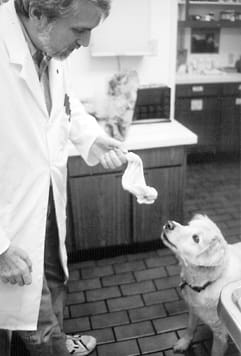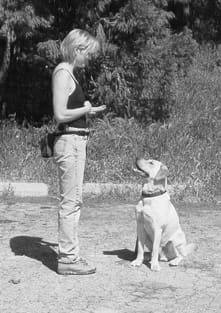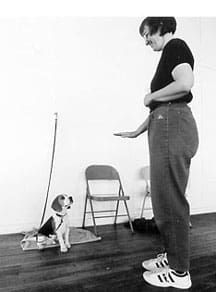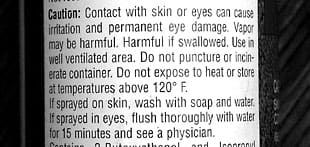Deborah, one of the members of the local dog-training club, regularly fills her prescription for Synthyroid at a large chain pharmacy in town. She will take this drug for life due to her underactive thyroid gland. Deborah regularly checks pricing for the drug at several pharmacies to ensure she continues to pay competitive rates.
Susan, also a club member, regularly purchases Soloxine, a lifetime prescription medication also indicated for an underactive thyroid condition. Both prescriptions have the same basic active ingredient: Levothyroxine.
Susan, however, administers the prescription she buys to her dog, Jo.
Like many guardians of companion dogs, Susan is faced with new options about deciding where to economically and safely purchase prescription medicines for her dog.
Traditionally dispensed solely from the veterinarian’s office, prescription drugs for companion dogs represent a ripe peach – ready for picking by retail chain pharmacies and emerging Internet-based pharmacies that have sniffed out a promising new niche in the lucrative pharmaceutical market. These drug retailers have discovered the more than 35 million dog owners in the United States who anticipate the same access to sophisticated medicines for their dogs as they have come to expect for themselves.
As quickly as animal pharmaceutical companies rush to the Food and Drug Administration’s Center for Veterinary Medicine (CVM) with applications requesting approval for new drugs or new drug uses for animals, the pharmaceutical retailers are rushing to the consumer with discount price offers. But just how attractive are these discount drug deals, and how will this increased competition for the guardian’s dollar in the companion animal drug market affect the veterinarians’ practices?
New competition
When the telephone company was affectionately known as “Ma Bell,” it held a monopoly position in telephone communications. AT&T sometimes used revenues collected for its most profitable services to subsidize less lucrative activities, such as providing telephone service to remote towns at affordable rates. Then, competitors focusing on the most profitable pieces of the market, like long distance service in major cities, picked off those segments of the business, leaving the less-lucrative segments behind. Thus began a restructuring of the telecommunications industry’s rates, with each individual service either fully supporting itself or disappearing.
Until very recently, most veterinary practices ran their businesses much like the Ma Bell of 20 years ago. The sale of veterinary pharmaceuticals was a profitable part of the average veterinary practice, accounting for about 20 to 30 percent of the total average practice income. Most veterinarians follow the recommendations of practice consultants and drug manufacturers to mark-up pharmaceuticals about 100 percent over their cost of the drugs. This subsidizes other veterinary services, such as affordable spay and neuter programs and upgrades in medical equipment. It also helps to hold fees at moderate levels for hospitalization, radiographs, and professional services like examination and diagnosis, thereby enabling these procedures to be available to a greater number of animals.
In other words, just as in the “old Ma Bell” model, many of the services provided by the veterinarian’s office are not priced to the consumer in direct relationship to the veterinarian’s cost of providing the service. And today, just as with the lucrative long-distance slice of the telephone industry, one of the most lucrative segments of the veterinary market – long-term prescription drugs – is under siege by other drug retailers and Internet pharmacies.
Some veterinarians, feeling the pinch as more and more clients request written prescriptions that they can fill elsewhere (rather than purchasing their dogs’ medications from the veterinarian), have instituted a charge for writing prescriptions.
However, other veterinarians say they understand why some clients, especially those whose dogs require long-term or especially expensive drug therapy, need to economize where possible, given their significant and ongoing investment in their animals’ care.
Different prescription needs
Generally speaking, there are a handful of situations involving prescription veterinary medications. Some lend themselves to bargain hunting; others do not.
In the first scenario, a dog has an acute illness of some kind, requiring the immediate administration of a short-term medication. Say, he’s got conjunctivitis, and needs an antibiotic ointment, or a urinary tract infection, and needs antibiotic therapy for a week. Most of us, in situations such as these, would gladly pay the veterinarian for the relatively inexpensive medications, and take them home with the dog.
Emergency medical situations are another example of a time when most of us would rather pay our veterinarians for immediate access to any medications required– at almost any price – to save our dogs.
But there are other situations where doing some bargain hunting makes sense. One is in the case of common veterinary preparations that a dog owner might use fairly frequently, such as Heartgard, a heartworm preventive. Typically, these items are marked up 100 percent, but they can be found at prices representing as much as 200 or 300 percent of their wholesale price. Finding a discount outlet for these brand-name items, especially if one has several dogs, only makes sense.
More significant is the case where someone has a dog with a serious medical condition that calls for expensive, long-term drug therapy. People whose dogs receive prescription medication for long-term health problems such as heart conditions, thyroid, seizure disorders, Cushing’s Disease, and even serious behavior problems may spend as much as hundreds of dollars a month on their dogs’ drugs. (See “A Tale of Two Prescriptions” sidebar) Saving half of that money by buying the drugs for less from an outlet other than the veterinarian may well be imperative for preventing what some veterinarians call “economic euthanasia,” where an owner feels forced to put a dog to sleep because she can’t afford the medicine needed to keep him well.
Keep in mind that insuring your dog with a veterinary health insurance plan or joining a membership discount organization may eliminate the need to shop for discounted prices. For more information on these plans, see “Covered Pup,” WDJ July 2002.
Pricing a prescription
The most important piece of information to take away from this article is that prescription drug prices vary dramatically among retailers. It takes a bit of work to gather all the relevant information from the possible sources of prescription medications for your dog, but it’s well worth the effort.
First, check for human brand name equivalents and generics. Ask your veterinarian if she can prescribe a human drug with the same ingredients as the veterinary drug. Sometimes, the equivalent human drug costs less than the veterinary drug, even though there may be absolutely no difference between them. The practice of giving drugs that have been approved for humans to animals is known as prescribing “off-label,” and is restricted by the FDA to animals not used in the production of food for human consumption.
An example of this is Etogesic, manufactured for animals by Fort Dodge Animal Health, and Lodine, the human equivalent manufactured by Wyeth-Ayerst Pharmaceuticals. Both drugs are nonsteroidal anti-inflammatories commonly prescribed for pain. Both utilize the same active ingredient: Etodolac. Price both prescriptions for a full accounting of available costs for the drug.
Next, call every pharmacy in your area and ask how much they charge for that prescription. Make sure to ask for the price of the veterinary drug, its human equivalent (if it has one), and its generic form. Make sure you confirm the dose and the amount with the pharmacist.
If the drug comes in tablets, ask about “pill splitting.” Often, drugs cost less, compared milligram to milligram, in higher-dose tablets than lower-dose tablets. For example, say your dog is supposed to take 80 mg of a drug per day; 40 mg in the morning and 40 mg at night. It may be less expensive to buy 80 mg tablets and cut them in two, feeding him half a tablet twice a day, than to buy 40 mg tablets. (This won’t work with capsules, and works best with tablets that are scored in the middle. Tiny tablets may be too difficult to cut accurately.)
Trying alternative pharmacies
You may be able to realize further savings by taking your veterinarian’s prescription to an Internet or catalog pharmacy. These outlets can sometimes offer deeper discounts than “brick and mortar” businesses, since they have less overhead. However, keep the following in mind when shopping at mail-order pharmacies:
For an accurate price analysis, add shipping and handling costs to the price quoted for the medicine. These factors may erase any savings that you thought you would realize by purchasing from a catalog or Internet pharmacy.
It’s easier for unscrupulous pharmacies to get away with illegal practices when they don’t maintain local retail outlets. There have been numerous complaints that Internet pharmacies, especially, dispense “knock-off” and foreign drugs, or drugs not approved by the FDA for use in animals. Ask for a written guarantee that the pharmacy offers only drugs approved by the Food and Drug Administration (FDA), does not use bulk drug chemicals manufactured for overseas production to concoct imitations of approved drugs, and does not sell foreign-made versions of U.S. products. Some U.S. drug companies will not accept responsibility for their products purchased in the U.S. over the Internet if the products were manufactured to non-U.S. specifications. (See “Problems with Internet Pharmacies” sidebar.)
Your veterinarian must be kept “in the loop.” Several Internet pharmacies have engaged “staff” veterinarians to write prescriptions for consumers who order drugs online. In all but a few states it is illegal to dispense prescription drugs without the benefit of a traditional doctor-patient relationship. This law ensures that a medical professional monitors the condition of any patient taking the prescription medication, including making a proper diagnosis, checking for drug interactions, and managing the possible side-effects of the drug.
The administration of some drugs to a dog may require follow-up blood tests, urine tests, or other actions to monitor the impact of the drug on the dog’s various body systems. Also, a veterinarian should check dogs taking multiple prescription medications for the possible harmful effects of drug interactions. No matter where you buy your dog’s medications, their use must be monitored by your veterinarian.
Mail-order pharmacies may not be fast enough. Some prescriptions, such as antimicrobials prescribed to treat infections, should be administered to the animal immediately. Adding time for shopping, ordering, and shipping drugs may endanger the dog’s health.
Work with your vet
We’re not trying to put the squeeze on veterinarians, but we do think that cost-conscious guardians who purchase prescription medications can be responsible consumers by buying from a reputable source while maintaining the doctor-patient relationship between their veterinarian and their dog.
If you contemplate buying medicines from retailers, catalogs, or Internet sources, run the prices by your veterinarian before making your purchase. Several veterinarians we interviewed mentioned that, if their good clients find a much lower price for prescription medications outside their practice, they would do everything they could to at least meet the price.
-by Lorie Long
Lorie Long lives in North Carolina with two Border Terriers, Dash (a three-year-old female and agility queen) and Chase (a five-month-old male with an agility future).












